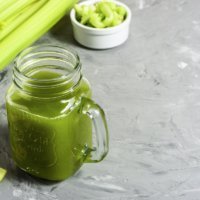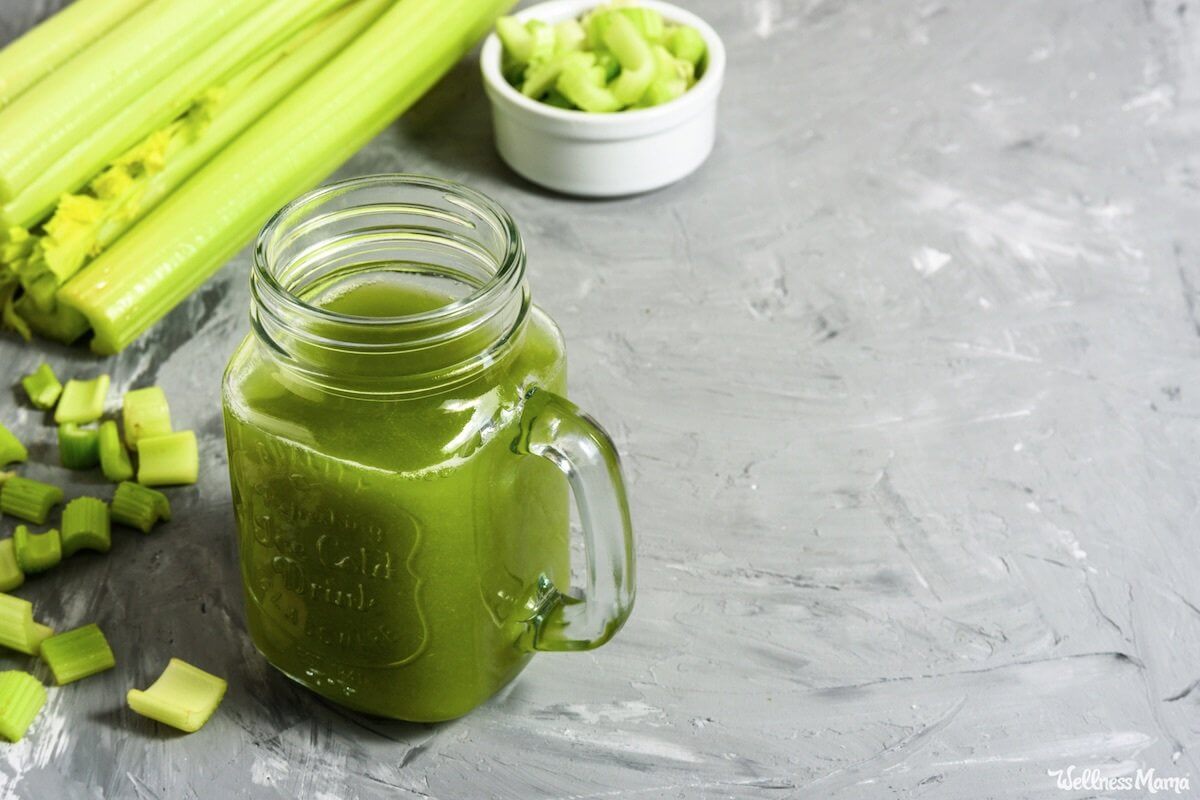I’m a huge fan of green smoothies because they are an easy way to pack a lot of nutrition into a tasty drink (and kids love them!). I still love my green smoothies, but I’m also experimenting with green juices for their health benefits. Celery juice recipes have been popular, so today I want to talk about the benefits of drinking celery juice and whether it’s all it’s cracked up to be.
Is Celery Juice a Superfood… or a Fad?
Although celery does contain many health benefits, celery juice is not meant to replace a healthy diet and lifestyle. Drinking lots of celery juice won’t fix a poor diet or lack of exercise. In fact, there are no single remedies or foods that eaten or taken alone can have a huge improvement on health. That’s just not how the body works.
A well-rounded diet (that includes a variety of superfoods) and other healthy lifestyle choices are the best way to live a healthy life. Celery juice is a superfood that can be included in a healthy diet and lifestyle for its many health benefits.
How the Craze Began
The celery juice movement was started by a book, Celery Juice: The Most Powerful Medicine of Our Time Healing Millions Worldwide by Anthony William (he calls himself the Medical Medium). This book recommends drinking 16 ounces of celery juice every morning on an empty stomach to relieve many health issues including weight loss and high blood pressure.
Unfortunately, there isn’t a whole lot of scientific evidence to support William’s claims about celery juice. However, there is evidence that celery has health benefits but we have to look at it in terms of the whole diet and lifestyle.
Benefits of Celery Juice
Celery leaf, seed, and extract have been popular remedies in traditional plant medicine practices for centuries. A 2017 review published in the Journal of Evidence Based Complementary and Alternative Medicine states that celery:
- can help avoid heart disease, jaundice, urinary tract problems, gout, and rheumatoid disorders
- improve fertility
- increase sperm counts
- is antifungal and antibacterial
- can be used for bronchitis, colic, asthma, skin conditions, fevers, vomiting, and tremors
Celery has many uses as a medicinal plant, but it also has several general health-promoting properties that everyone can benefit from. We try to use a fair amount of celery in traditional ways: filled with nut butter, diced in chicken salad, etc., but it’s hard to get a large quantity of celery in. (Plus all that chewing!)
That’s where juicing comes in.
Nutrient Dense
We have heard a number of times that celery is a negative calorie food because it takes more energy to digest than it provides. But I think this is looking at celery in the wrong way. I’m not one for counting calories, as they are not all equal, so I don’t care about how many calories celery has or doesn’t have. Celery’s nutrient content is much more important to me and is proving to be a great addition to a healthy diet.
Celery is a highly nutritious food. The review listed above also suggests that celery is a sought-after vegetable for its health benefits because it contains a large amount of vitamin C as well as retinoids and carotenoids (precursors to vitamin A). Celery also contains:
- vitamin k
- molybdenum
- potassium
- folate
- pantothenic acid
- vitamins B2 & B6
- copper
- manganese
- magnesium
It’s always better to get vitamins and minerals from food when you can, and celery packs a nutritional punch!
Rich in Antioxidants
Antioxidants like flavonoids fight disease-causing free radicals that build up in the body and lead to acute and chronic health problems. According to the review, celery contains this antioxidant line-up:
- caffeic acid
- p-coumaric acid
- ferulic acid
- apigenin
- luteolin
- tannin
- saponin
- kaempferol
These powerful antioxidants support the body in reducing inflammation and fighting off disease.
Anti-Inflammatory
Along with antioxidants, celery contains other promising compounds that fight inflammation. This has researchers looking into the benefits of celery for individuals that struggle with chronic illness. A 2017 study in the Journal of Asian Natural Products Research shows that certain compounds in celery can alter the processes of inflammatory-producing molecules, reducing inflammation in the body.
Supports Heart Health
Celery is an excellent vegetable to support a healthy heart. A 2015 study in the Avicenna Journal of Phytomedicine shows that celery decreased cholesterol and blood pressure in rats that received a celery leaf extract. And a 2013 study backs it up, reporting that celery has properties that help to relax the cardiovascular system and may be a potential treatment for those with hypertension.
All of these benefits make it easy to see why celery is considered a superfood. Eating raw celery, juicing and cooking with it provides the body with many positive health benefits.
Benefits of Drinking Celery Juice
Celery obviously has many benefits when included in the diet, so many people wonder why juicing is necessary. The reason celery juice may be a better health choice than eating celery whole is that celery juice has the fiber removed. Celery juice contains all of the vitamins, minerals, and other compounds of celery, but is easier to consume large amounts of it.
Fiber is very important for a healthy diet and lifestyle, but removing it to make vegetable juices may be a good way to get the most nutrition with less bulk.
Juicing is not always a good idea though, like in the case of fruit. Fruits are high in sugar but when eaten whole the sugars are balanced fairly well by the fiber. Fruit juice, with the fiber removed, may cause blood sugar spikes so I don’t recommend drinking large amounts of fruit juice (even freshly squeezed!).

Celery Juice Recipe
Servings
Ingredients
- 2 bunches celery
Instructions
Juicer Method
- Chop off the leafy tops and the root base of the celery bunches.
- Place the celery stalks in a colander and rinse them with water.
- Gently wipe off any dirt lingering on the stalks.
- Feed the celery stalks through the juicer and collect the juice in a glass jar.
- Add a few ice cubes to quickly chill it and enjoy.
Blender Method
- Chop off the leafy tops and the root base of the celery bunches.
- Place the celery stalks in a colander and rinse them with water.
- Gently wipe off any dirt lingering on the stalks.
- Cut the celery stalks into thirds, and place the stalks in the blender.
- Pour ¼ cup of water over the celery stalks and blend until smooth. You may need to press the stalks down using a spoon as you blend.
- Place a nut milk bag or cheesecloth over a jar or pitcher.
- Pour the blended celery into the nut milk bag.
- Using your hands, squeeze the blended celery so the juices run through the bag.
- Once the blended celery is no longer dripping, remove it from the jar. Your juice is ready to be served.
- Add a few ice cubes to quickly chill it and enjoy.
- Refrigerate any leftover juice in a jar with a tight-fitting lid.
Nutrition
Notes
- I’ve tried both of these methods. Although using a juicer is much easier, the blender method still creates a satisfying and healthy drink.
- It is normal for the juice to look separated when it settles. Simply give it a few quick shakes before pouring it into a glass.
- While William recommends drinking 16 ounces first thing in the morning, I couldn’t find any clear and evidence supported reason for doing this, so I would just do what feels right for you.
Is It Important to Use Organic Celery?
Surprisingly, science shows that organic and non-organic produce contain quite similar levels of nutrients. A 2012 review found that organic foods were not significantly more nutritious than non-organic foods.
However, there are benefits to eating (and juicing) organic produce that go beyond just the levels of nutrients in the food. The review I mentioned above also states that choosing organic food reduces exposure to pesticides and antibiotic-resistant bacteria.
When I’m choosing between organic and non-organic produce, I use the Environmental Working Group’s (EWG) Shopper’s Guide to Pesticides in Produce. They put out the Dirty Dozen (12 fruits and vegetables with the highest levels of pesticide residue) and the Clean Fifteen (15 fruits and vegetables with the lowest levels of pesticide residue).
Celery is listed in the Dirty Dozen category. Because of that, I usually buy organic celery. If purchasing organic is not in the budget, buy non-organic and clean the celery with an all-natural produce wash before juicing. Eating a whole food diet with non-organic produce is still healthier than highly-processed, sugary junk food.
How to Get Kids to Drink Celery Juice
Getting kids to eat (and drink) healthy can be a challenge. But it is possible! Try these tips:
- Celery juice is slightly bitter on its own. I’ve found that mixing celery with other fruits and vegetables is the best way to get kids to drink celery juice.
- Low-sugar vegetable juices are the best options for making celery juice a bit tastier without lowering the health quality of the drink. My kids really love carrots, cucumbers, and celery together.
- Sometimes kids need a little time to adjust to new foods (especially green vegetables). Juicing their favorite fruits and vegetables (apples, oranges, etc.) along with celery may help them open up to this bitter drink. I would just be careful to only use as much fruit as is necessary for taste (and consider backing off on the fruit as your child adjusts).
- Be sure to get the kids involved in the juicing process. For my kids, being allowed to help out in the kitchen is the best way to get them excited about trying new foods.
How to Eat More Celery
Celery certainly doesn’t only belong in juice. The health benefits of celery can be obtained by adding more of this crunchy veggie into your diet on a regular basis. It goes great in soups, stews, chopped up in salads, and even tastes good dipped in almond butter for a midday snack. These are a few of my favorite recipes using celery:
- Root Vegetable Grain Free Stuffing
- Healthy Chicken Salad
- Easy Leftover Turkey Soup
- Gluten-Free Chicken Pot Pie
Celery is versatile and makes a great snack for kids (and adults). A friend of mine encourages her kids to eat celery by calling it “celery smiles” rather than just plain, old celery. Sometimes the simplest tricks have the biggest impact when it comes to kids!
This article was medically reviewed by Dr. Ann Shippy, who is Board Certified in Internal Medicine and a certified Functional Medicine physician with a thriving practice in Austin, Texas. As always, this is not personal medical advice and we recommend that you talk with your doctor.
Have you tried juicing celery? What do you think about it?


Leave a Reply